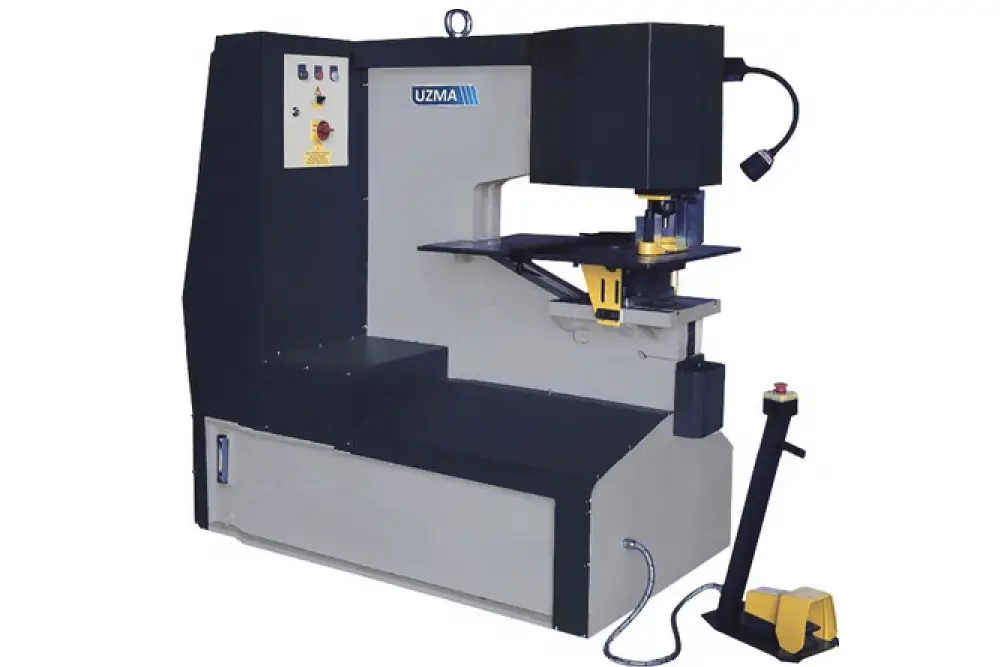Hydraulic Ironworker Machine
In the field of metalworking, versatility, accuracy, and efficiency are critical. One machine that epitomizes these qualities is the hydraulic ironworker. This multifaceted apparatus is a staple in workshops and factories worldwide, serving as a cornerstone for various metal fabrication tasks. Its versatility makes it vital for tasks like shearing plates and punching holes.
The hydraulic ironworker machine is a sturdy and adaptable tool made to carry out a wide range of metalworking operations with remarkable accuracy and effectiveness. It comprises several essential components, including hydraulic cylinders, shearing blades, punching units, notching stations, and bending attachments. These components work in tandem to enable a wide range of operations, making the hydraulic ironworker a cornerstone of metal fabrication processes. It is a vital tool especially in the field of metalworking.
Functions of Hydraulic Ironworker Machine
One of the primary functions of a hydraulic ironworker is punching holes in various metal workpieces. Equipped with interchangeable punch and die sets, the machine can produce holes of different shapes and sizes with remarkable accuracy. This capability is critical in applications like the manufacturing of structural steel, where accurate hole placement is necessary for assembly.
Shearing flat and angle iron, as well as round and square bar material, is also an area of expertise for the hydraulic ironworker. Thanks to its powerful hydraulic system and high-quality blades, it can effortlessly cut through metal sheets of varying thicknesses, ensuring clean and precise cuts. This function is indispensable in tasks like cutting metal plates to size or trimming excess material from workpieces.
Another important function of the hydraulic ironworker is notching, which includes cutting V-shaped grooves or notches into metal components. This procedure is often used to create joints, corners, and interlocking elements in metalwork, which improves structural integrity and makes assembly easier. The machine's adjustable notching station provides fine control over notch depth and angle, making it suitable for a wide range of fabrication applications.
Many hydraulic ironworkers come equipped with bending attachments or press brakes, enabling them to perform bending operations on metal sheets and profiles. This function is extremely useful for forming metal components into specific shapes or angles, such as brackets, channels, or flanges. By incorporating bending functionality, the machine increases versatility and speeds the production process.
Applications of Hydraulic Ironworker
Hydraulic ironworkers play a vital role in metal fabrication industries, including construction, automotive, aerospace, and manufacturing. They are utilized to produce a wide range of components, including beams, plates, brackets, and frames, with unrivalled precision and efficiency. Whether cutting, punching, or bending, these machines excel at shaping metal components to exact specifications.
In structural steel fabrication, hydraulic ironworkers are indispensable for operations such as punching holes in beams and columns, shearing plates for gussets and connections, and notching members for weld preparation. Their ability to handle heavy-duty materials and conduct several operations in a single setup makes them significant assets when constructing buildings, bridges, and other structures.
Hydraulic ironworkers are often found in metalworking workplaces of all sizes, functioning as versatile workhorses for a wide range of applications. These machines serve to a wide range of metalworking demands, from small-scale operations like making custom metal brackets to large-scale undertakings like manufacturing industrial gear, increasing efficiency and production.
Beyond manufacturing and fabrication, hydraulic ironworkers are utilized in maintenance and repair operations across various industries. Whether it's repairing worn-out parts, upgrading existing structures, or creating unique components on-site, these machines provide the versatility and competence to handle a wide range of metalworking issues.


